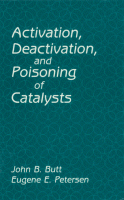Browse content
Table of contents
Actions for selected chapters
- Full text access
- Book chapterNo access
INDEX
Pages 489-495
About the book
Description
Activation, Deactivation, and Poisoning of Catalysts deals with the circumstances and mechanisms underlying catalyst activation, deactivation, and poisoning. The emphasis is on the techniques for handling deactivating systems, not on results per se. Deactivation by fouling and sintering is given consideration. This book is organized into three sections and consists of 12 chapters. The first part is devoted to a systematic development of the manner in which catalysts are activated, deactivated, poisoned, and in some cases reactivated on a microscopic basis. The first chapter explains the concept of the active center as utilized in catalysis, along with catalyst regeneration, rejuvenation, and detoxification. In the second part, the reader is introduced to the problem of heat transfer as well as the transport of reactants and products in the interior of the particle coupled with chemical reaction therein. The macroscopic deactivation behavior of the catalyst particle is described in terms of fundamental kinetic deactivation phenomena and of parameters governing heat and mass transfer. The last part is primarily concerned with a collection of catalyst particles within the reactor, with emphasis on the global activity of the reactor. In the last chapter, a pragmatic approach is presented to predict the design and performance of chemical reactors containing a deactivating catalyst. This book is written for catalytic chemists, researchers, reactor designers, and students interested in catalyst activation, deactivation, and poisoning.
Activation, Deactivation, and Poisoning of Catalysts deals with the circumstances and mechanisms underlying catalyst activation, deactivation, and poisoning. The emphasis is on the techniques for handling deactivating systems, not on results per se. Deactivation by fouling and sintering is given consideration. This book is organized into three sections and consists of 12 chapters. The first part is devoted to a systematic development of the manner in which catalysts are activated, deactivated, poisoned, and in some cases reactivated on a microscopic basis. The first chapter explains the concept of the active center as utilized in catalysis, along with catalyst regeneration, rejuvenation, and detoxification. In the second part, the reader is introduced to the problem of heat transfer as well as the transport of reactants and products in the interior of the particle coupled with chemical reaction therein. The macroscopic deactivation behavior of the catalyst particle is described in terms of fundamental kinetic deactivation phenomena and of parameters governing heat and mass transfer. The last part is primarily concerned with a collection of catalyst particles within the reactor, with emphasis on the global activity of the reactor. In the last chapter, a pragmatic approach is presented to predict the design and performance of chemical reactors containing a deactivating catalyst. This book is written for catalytic chemists, researchers, reactor designers, and students interested in catalyst activation, deactivation, and poisoning.
Details
ISBN
978-0-12-147695-3
Language
English
Published
1988
Copyright
Copyright © 1988 Elsevier Inc. All rights reserved.
Imprint
Elsevier
